Reflective Paper on Nursing Reflection Assignment
VerifiedAdded on 2023/04/08
|8
|1807
|416
AI Summary
This reflective paper discusses a clinical situation observed in the emergency room during a nursing placement, using Gibb's reflection cycle. It explores the ability to utilize critical thinking and theoretical basis to enhance clinical knowledge. The paper also evaluates feelings, analysis, and action plan for future nursing practice.
Contribute Materials
Your contribution can guide someone’s learning journey. Share your
documents today.
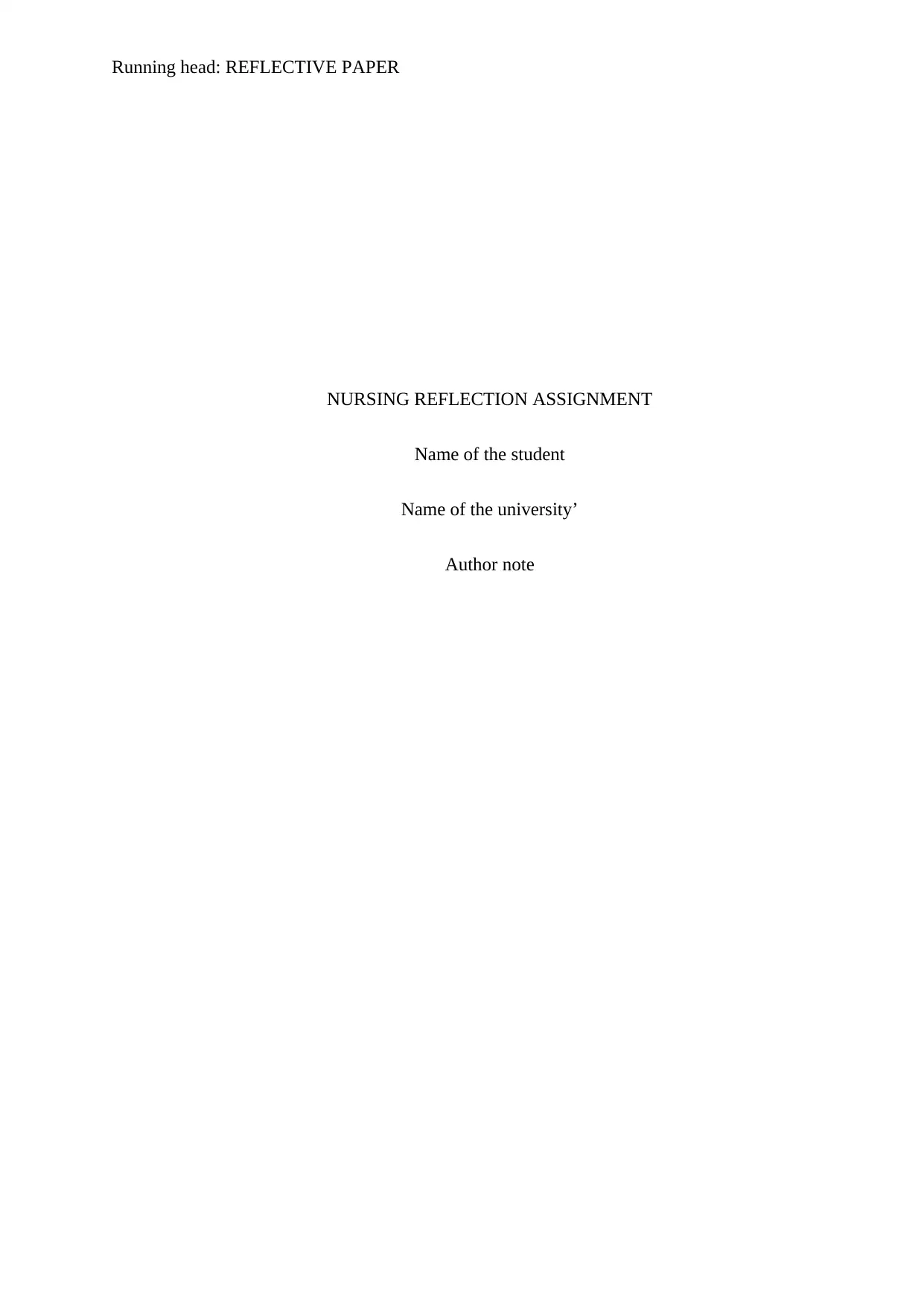
Running head: REFLECTIVE PAPER
NURSING REFLECTION ASSIGNMENT
Name of the student
Name of the university’
Author note
NURSING REFLECTION ASSIGNMENT
Name of the student
Name of the university’
Author note
Secure Best Marks with AI Grader
Need help grading? Try our AI Grader for instant feedback on your assignments.

1REFLECTIVE PAPER
Introduction
Reflective practice is termed as a crucial aspect of the nursing profession as it
provides the professionals with the ability to enhance their personal and professional skills by
enhancing their skills and knowledge related to clinical practice (Redmond 2017). In this
reflective paper, I would be reflecting upon one clinical situation, I observed in my clinical
placement in the emergency room and in this aspect, I would be using Gibb’s reflection
cycle. Further, with the help of this reflection, as per Smith and Roberts (2015), I would be
discussing my ability to utilize critical thinking and theoretical basis depending on which I
perceived the clinical situation and increased my clinical knowledge.
Description of the situation
While my clinical placement in the King Abdullah Bin Abdulaziz University Hospital
(KAAUH), I was posted in the emergency room (ER) for 5 weeks. During this placement, I
observed and experienced a clinical situation that provided me with an opportunity to
understand my strengths and weaknesses. My week in the ER started comfortably and with
the support and cooperation of the nursing professionals and physicians in the ER, I was able
to implement my learnings related to patient education, patent assessment, developing care
and treatment plan. However, at the end of the 5th week, one patient AB was admitted the
ER, due to which I was able to understand the critical healthcare condition that advanced
nursing professional go through in the clinical situation. The patient AB (54) (pseudonym)
was shifted in the ER after primary assessment and while her admission in the emergency
room, she was breathing heavily and was fidgeting on the stretcher. This was a regular
scenario in the healthcare facility, however, the situation that occurred while the physical
assessment by the physician, tested my abilities as a future advanced practice nursing
professional.
Introduction
Reflective practice is termed as a crucial aspect of the nursing profession as it
provides the professionals with the ability to enhance their personal and professional skills by
enhancing their skills and knowledge related to clinical practice (Redmond 2017). In this
reflective paper, I would be reflecting upon one clinical situation, I observed in my clinical
placement in the emergency room and in this aspect, I would be using Gibb’s reflection
cycle. Further, with the help of this reflection, as per Smith and Roberts (2015), I would be
discussing my ability to utilize critical thinking and theoretical basis depending on which I
perceived the clinical situation and increased my clinical knowledge.
Description of the situation
While my clinical placement in the King Abdullah Bin Abdulaziz University Hospital
(KAAUH), I was posted in the emergency room (ER) for 5 weeks. During this placement, I
observed and experienced a clinical situation that provided me with an opportunity to
understand my strengths and weaknesses. My week in the ER started comfortably and with
the support and cooperation of the nursing professionals and physicians in the ER, I was able
to implement my learnings related to patient education, patent assessment, developing care
and treatment plan. However, at the end of the 5th week, one patient AB was admitted the
ER, due to which I was able to understand the critical healthcare condition that advanced
nursing professional go through in the clinical situation. The patient AB (54) (pseudonym)
was shifted in the ER after primary assessment and while her admission in the emergency
room, she was breathing heavily and was fidgeting on the stretcher. This was a regular
scenario in the healthcare facility, however, the situation that occurred while the physical
assessment by the physician, tested my abilities as a future advanced practice nursing
professional.
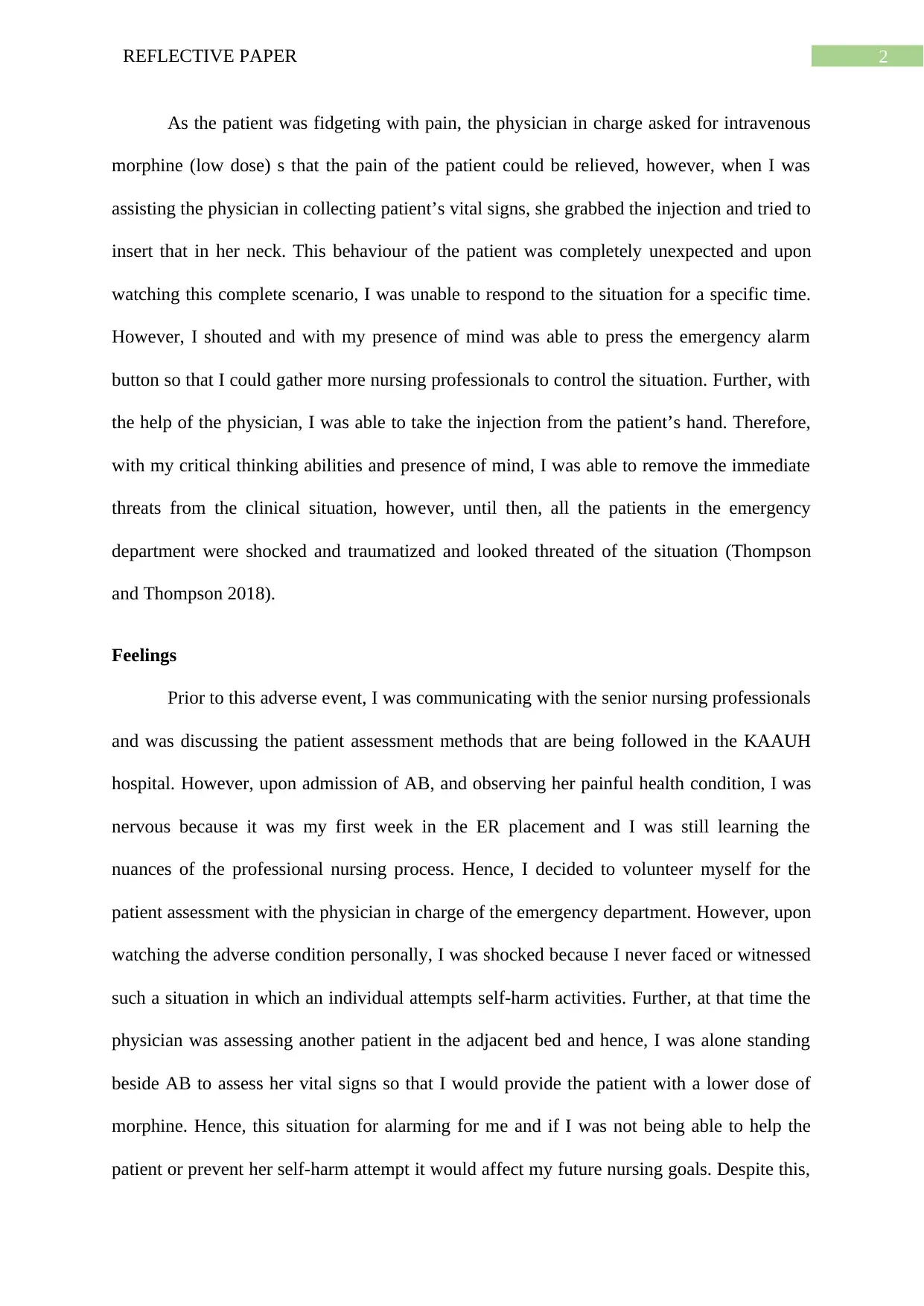
2REFLECTIVE PAPER
As the patient was fidgeting with pain, the physician in charge asked for intravenous
morphine (low dose) s that the pain of the patient could be relieved, however, when I was
assisting the physician in collecting patient’s vital signs, she grabbed the injection and tried to
insert that in her neck. This behaviour of the patient was completely unexpected and upon
watching this complete scenario, I was unable to respond to the situation for a specific time.
However, I shouted and with my presence of mind was able to press the emergency alarm
button so that I could gather more nursing professionals to control the situation. Further, with
the help of the physician, I was able to take the injection from the patient’s hand. Therefore,
with my critical thinking abilities and presence of mind, I was able to remove the immediate
threats from the clinical situation, however, until then, all the patients in the emergency
department were shocked and traumatized and looked threated of the situation (Thompson
and Thompson 2018).
Feelings
Prior to this adverse event, I was communicating with the senior nursing professionals
and was discussing the patient assessment methods that are being followed in the KAAUH
hospital. However, upon admission of AB, and observing her painful health condition, I was
nervous because it was my first week in the ER placement and I was still learning the
nuances of the professional nursing process. Hence, I decided to volunteer myself for the
patient assessment with the physician in charge of the emergency department. However, upon
watching the adverse condition personally, I was shocked because I never faced or witnessed
such a situation in which an individual attempts self-harm activities. Further, at that time the
physician was assessing another patient in the adjacent bed and hence, I was alone standing
beside AB to assess her vital signs so that I would provide the patient with a lower dose of
morphine. Hence, this situation for alarming for me and if I was not being able to help the
patient or prevent her self-harm attempt it would affect my future nursing goals. Despite this,
As the patient was fidgeting with pain, the physician in charge asked for intravenous
morphine (low dose) s that the pain of the patient could be relieved, however, when I was
assisting the physician in collecting patient’s vital signs, she grabbed the injection and tried to
insert that in her neck. This behaviour of the patient was completely unexpected and upon
watching this complete scenario, I was unable to respond to the situation for a specific time.
However, I shouted and with my presence of mind was able to press the emergency alarm
button so that I could gather more nursing professionals to control the situation. Further, with
the help of the physician, I was able to take the injection from the patient’s hand. Therefore,
with my critical thinking abilities and presence of mind, I was able to remove the immediate
threats from the clinical situation, however, until then, all the patients in the emergency
department were shocked and traumatized and looked threated of the situation (Thompson
and Thompson 2018).
Feelings
Prior to this adverse event, I was communicating with the senior nursing professionals
and was discussing the patient assessment methods that are being followed in the KAAUH
hospital. However, upon admission of AB, and observing her painful health condition, I was
nervous because it was my first week in the ER placement and I was still learning the
nuances of the professional nursing process. Hence, I decided to volunteer myself for the
patient assessment with the physician in charge of the emergency department. However, upon
watching the adverse condition personally, I was shocked because I never faced or witnessed
such a situation in which an individual attempts self-harm activities. Further, at that time the
physician was assessing another patient in the adjacent bed and hence, I was alone standing
beside AB to assess her vital signs so that I would provide the patient with a lower dose of
morphine. Hence, this situation for alarming for me and if I was not being able to help the
patient or prevent her self-harm attempt it would affect my future nursing goals. Despite this,
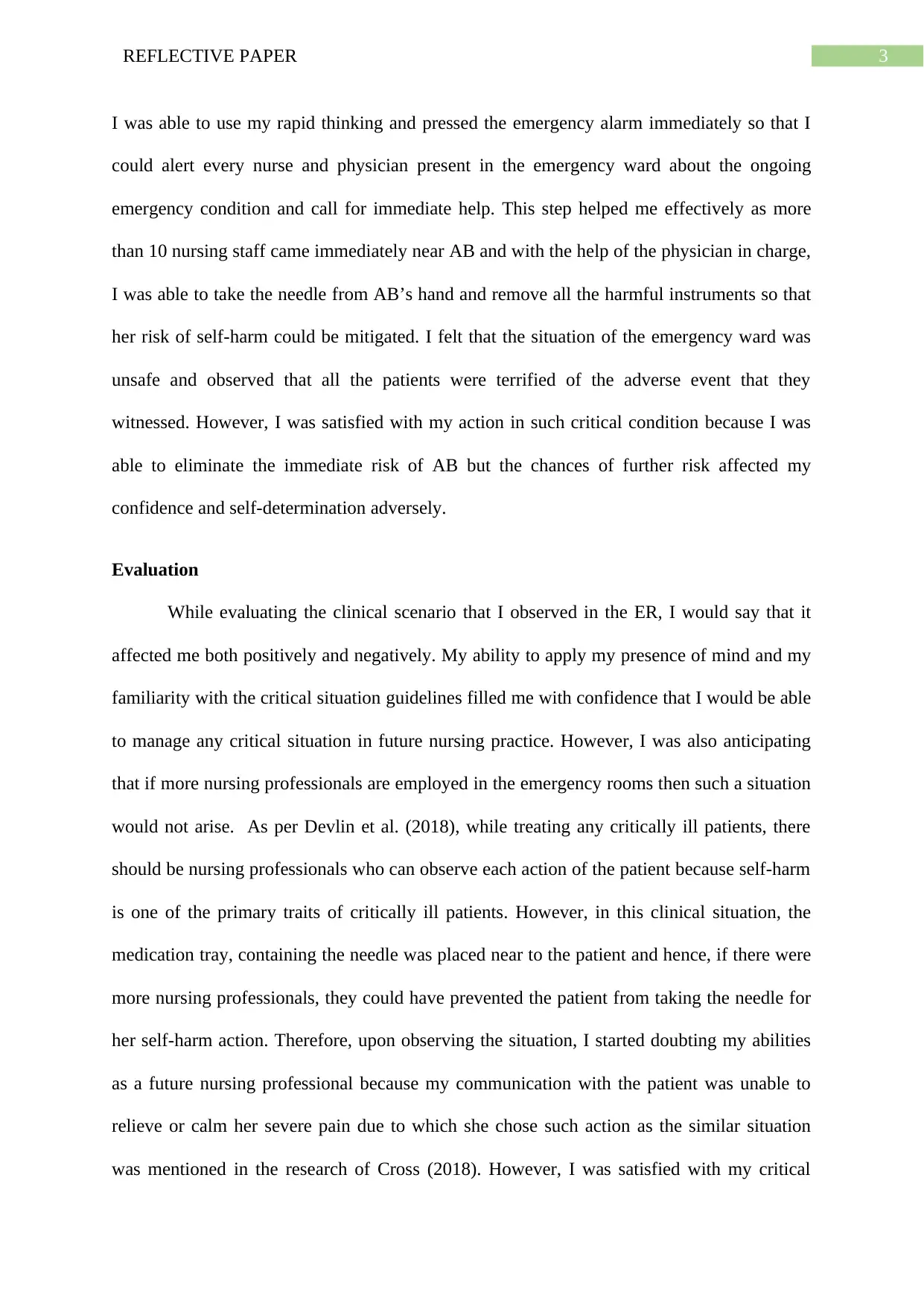
3REFLECTIVE PAPER
I was able to use my rapid thinking and pressed the emergency alarm immediately so that I
could alert every nurse and physician present in the emergency ward about the ongoing
emergency condition and call for immediate help. This step helped me effectively as more
than 10 nursing staff came immediately near AB and with the help of the physician in charge,
I was able to take the needle from AB’s hand and remove all the harmful instruments so that
her risk of self-harm could be mitigated. I felt that the situation of the emergency ward was
unsafe and observed that all the patients were terrified of the adverse event that they
witnessed. However, I was satisfied with my action in such critical condition because I was
able to eliminate the immediate risk of AB but the chances of further risk affected my
confidence and self-determination adversely.
Evaluation
While evaluating the clinical scenario that I observed in the ER, I would say that it
affected me both positively and negatively. My ability to apply my presence of mind and my
familiarity with the critical situation guidelines filled me with confidence that I would be able
to manage any critical situation in future nursing practice. However, I was also anticipating
that if more nursing professionals are employed in the emergency rooms then such a situation
would not arise. As per Devlin et al. (2018), while treating any critically ill patients, there
should be nursing professionals who can observe each action of the patient because self-harm
is one of the primary traits of critically ill patients. However, in this clinical situation, the
medication tray, containing the needle was placed near to the patient and hence, if there were
more nursing professionals, they could have prevented the patient from taking the needle for
her self-harm action. Therefore, upon observing the situation, I started doubting my abilities
as a future nursing professional because my communication with the patient was unable to
relieve or calm her severe pain due to which she chose such action as the similar situation
was mentioned in the research of Cross (2018). However, I was satisfied with my critical
I was able to use my rapid thinking and pressed the emergency alarm immediately so that I
could alert every nurse and physician present in the emergency ward about the ongoing
emergency condition and call for immediate help. This step helped me effectively as more
than 10 nursing staff came immediately near AB and with the help of the physician in charge,
I was able to take the needle from AB’s hand and remove all the harmful instruments so that
her risk of self-harm could be mitigated. I felt that the situation of the emergency ward was
unsafe and observed that all the patients were terrified of the adverse event that they
witnessed. However, I was satisfied with my action in such critical condition because I was
able to eliminate the immediate risk of AB but the chances of further risk affected my
confidence and self-determination adversely.
Evaluation
While evaluating the clinical scenario that I observed in the ER, I would say that it
affected me both positively and negatively. My ability to apply my presence of mind and my
familiarity with the critical situation guidelines filled me with confidence that I would be able
to manage any critical situation in future nursing practice. However, I was also anticipating
that if more nursing professionals are employed in the emergency rooms then such a situation
would not arise. As per Devlin et al. (2018), while treating any critically ill patients, there
should be nursing professionals who can observe each action of the patient because self-harm
is one of the primary traits of critically ill patients. However, in this clinical situation, the
medication tray, containing the needle was placed near to the patient and hence, if there were
more nursing professionals, they could have prevented the patient from taking the needle for
her self-harm action. Therefore, upon observing the situation, I started doubting my abilities
as a future nursing professional because my communication with the patient was unable to
relieve or calm her severe pain due to which she chose such action as the similar situation
was mentioned in the research of Cross (2018). However, I was satisfied with my critical
Secure Best Marks with AI Grader
Need help grading? Try our AI Grader for instant feedback on your assignments.
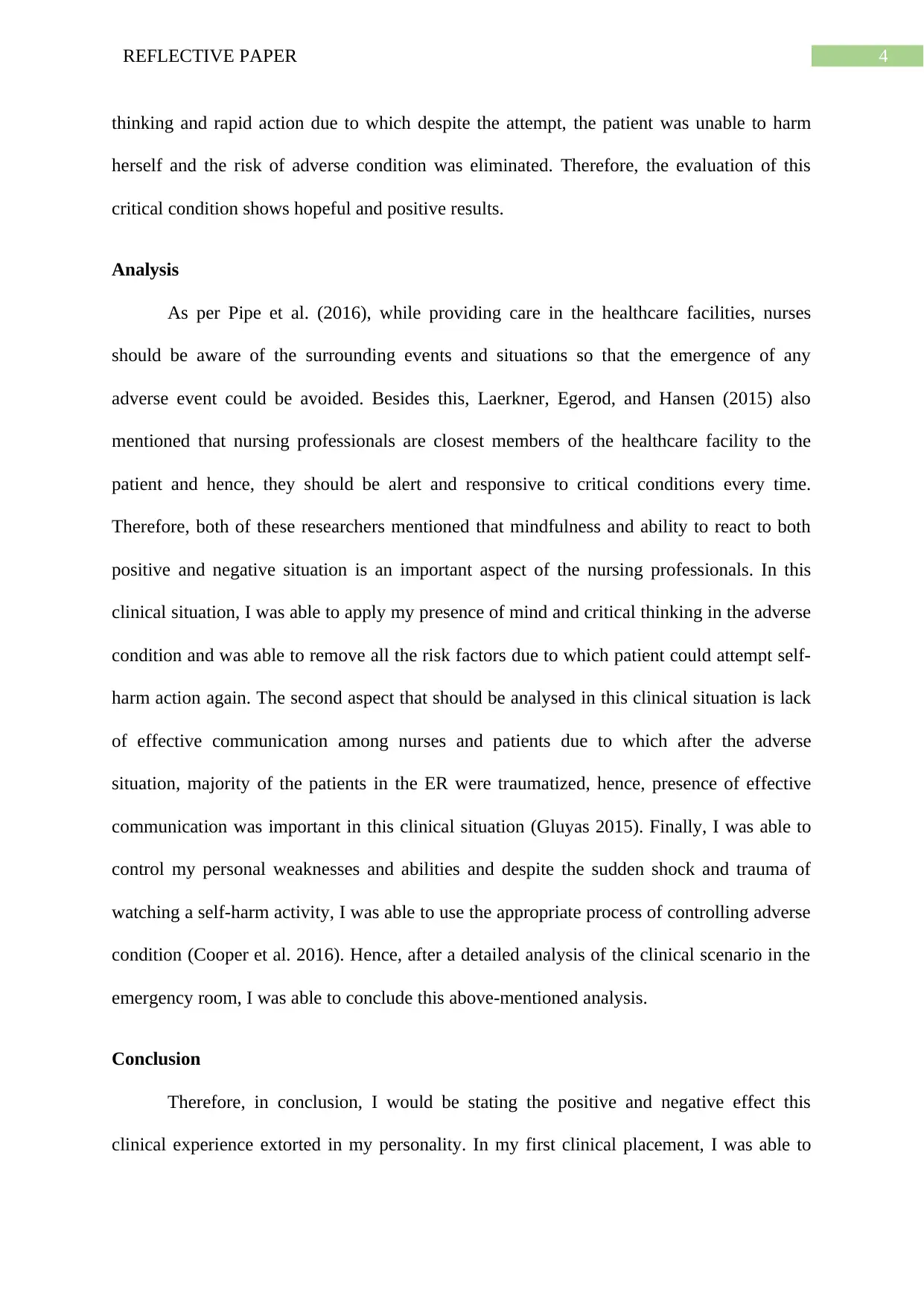
4REFLECTIVE PAPER
thinking and rapid action due to which despite the attempt, the patient was unable to harm
herself and the risk of adverse condition was eliminated. Therefore, the evaluation of this
critical condition shows hopeful and positive results.
Analysis
As per Pipe et al. (2016), while providing care in the healthcare facilities, nurses
should be aware of the surrounding events and situations so that the emergence of any
adverse event could be avoided. Besides this, Laerkner, Egerod, and Hansen (2015) also
mentioned that nursing professionals are closest members of the healthcare facility to the
patient and hence, they should be alert and responsive to critical conditions every time.
Therefore, both of these researchers mentioned that mindfulness and ability to react to both
positive and negative situation is an important aspect of the nursing professionals. In this
clinical situation, I was able to apply my presence of mind and critical thinking in the adverse
condition and was able to remove all the risk factors due to which patient could attempt self-
harm action again. The second aspect that should be analysed in this clinical situation is lack
of effective communication among nurses and patients due to which after the adverse
situation, majority of the patients in the ER were traumatized, hence, presence of effective
communication was important in this clinical situation (Gluyas 2015). Finally, I was able to
control my personal weaknesses and abilities and despite the sudden shock and trauma of
watching a self-harm activity, I was able to use the appropriate process of controlling adverse
condition (Cooper et al. 2016). Hence, after a detailed analysis of the clinical scenario in the
emergency room, I was able to conclude this above-mentioned analysis.
Conclusion
Therefore, in conclusion, I would be stating the positive and negative effect this
clinical experience extorted in my personality. In my first clinical placement, I was able to
thinking and rapid action due to which despite the attempt, the patient was unable to harm
herself and the risk of adverse condition was eliminated. Therefore, the evaluation of this
critical condition shows hopeful and positive results.
Analysis
As per Pipe et al. (2016), while providing care in the healthcare facilities, nurses
should be aware of the surrounding events and situations so that the emergence of any
adverse event could be avoided. Besides this, Laerkner, Egerod, and Hansen (2015) also
mentioned that nursing professionals are closest members of the healthcare facility to the
patient and hence, they should be alert and responsive to critical conditions every time.
Therefore, both of these researchers mentioned that mindfulness and ability to react to both
positive and negative situation is an important aspect of the nursing professionals. In this
clinical situation, I was able to apply my presence of mind and critical thinking in the adverse
condition and was able to remove all the risk factors due to which patient could attempt self-
harm action again. The second aspect that should be analysed in this clinical situation is lack
of effective communication among nurses and patients due to which after the adverse
situation, majority of the patients in the ER were traumatized, hence, presence of effective
communication was important in this clinical situation (Gluyas 2015). Finally, I was able to
control my personal weaknesses and abilities and despite the sudden shock and trauma of
watching a self-harm activity, I was able to use the appropriate process of controlling adverse
condition (Cooper et al. 2016). Hence, after a detailed analysis of the clinical scenario in the
emergency room, I was able to conclude this above-mentioned analysis.
Conclusion
Therefore, in conclusion, I would be stating the positive and negative effect this
clinical experience extorted in my personality. In my first clinical placement, I was able to
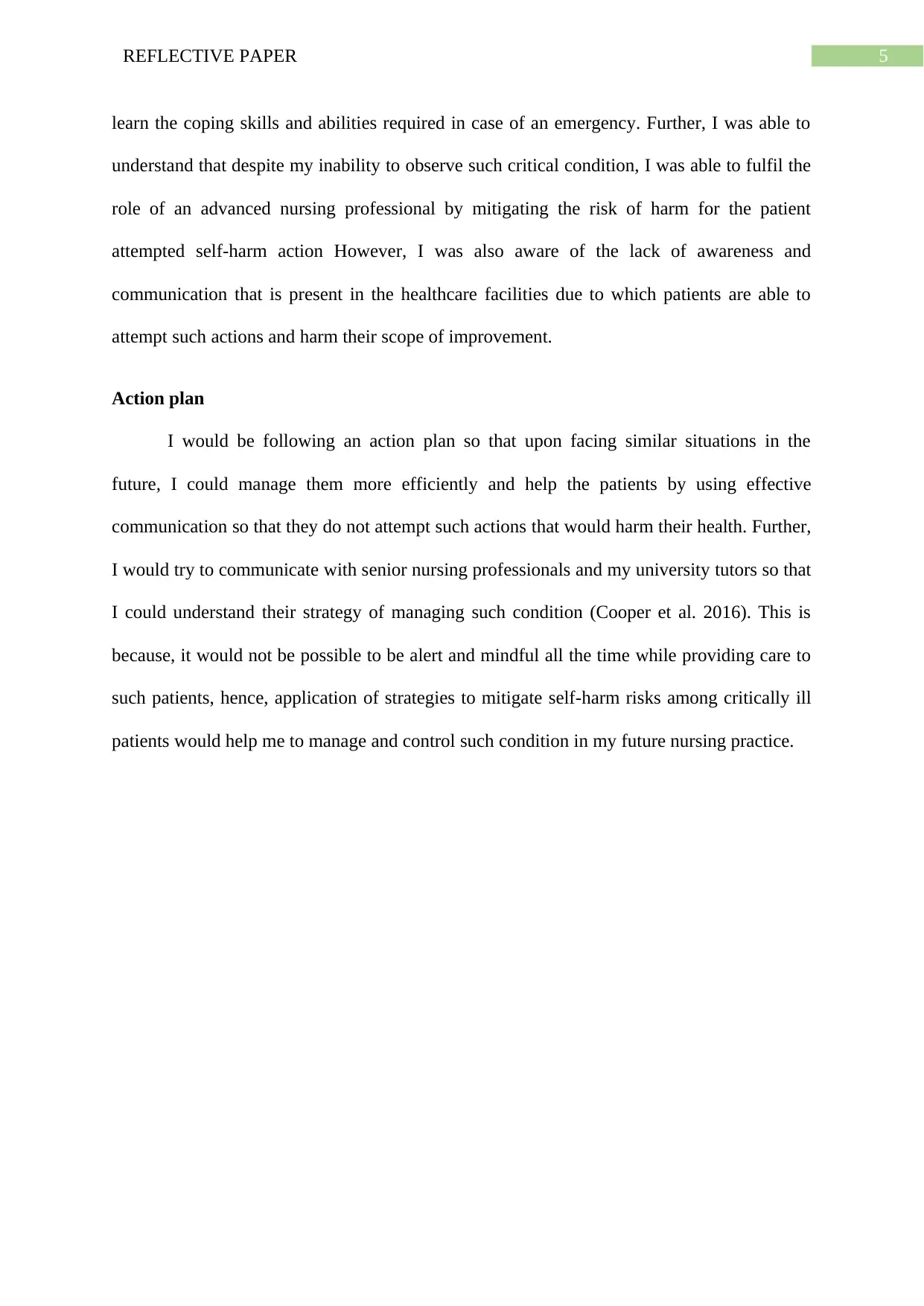
5REFLECTIVE PAPER
learn the coping skills and abilities required in case of an emergency. Further, I was able to
understand that despite my inability to observe such critical condition, I was able to fulfil the
role of an advanced nursing professional by mitigating the risk of harm for the patient
attempted self-harm action However, I was also aware of the lack of awareness and
communication that is present in the healthcare facilities due to which patients are able to
attempt such actions and harm their scope of improvement.
Action plan
I would be following an action plan so that upon facing similar situations in the
future, I could manage them more efficiently and help the patients by using effective
communication so that they do not attempt such actions that would harm their health. Further,
I would try to communicate with senior nursing professionals and my university tutors so that
I could understand their strategy of managing such condition (Cooper et al. 2016). This is
because, it would not be possible to be alert and mindful all the time while providing care to
such patients, hence, application of strategies to mitigate self-harm risks among critically ill
patients would help me to manage and control such condition in my future nursing practice.
learn the coping skills and abilities required in case of an emergency. Further, I was able to
understand that despite my inability to observe such critical condition, I was able to fulfil the
role of an advanced nursing professional by mitigating the risk of harm for the patient
attempted self-harm action However, I was also aware of the lack of awareness and
communication that is present in the healthcare facilities due to which patients are able to
attempt such actions and harm their scope of improvement.
Action plan
I would be following an action plan so that upon facing similar situations in the
future, I could manage them more efficiently and help the patients by using effective
communication so that they do not attempt such actions that would harm their health. Further,
I would try to communicate with senior nursing professionals and my university tutors so that
I could understand their strategy of managing such condition (Cooper et al. 2016). This is
because, it would not be possible to be alert and mindful all the time while providing care to
such patients, hence, application of strategies to mitigate self-harm risks among critically ill
patients would help me to manage and control such condition in my future nursing practice.
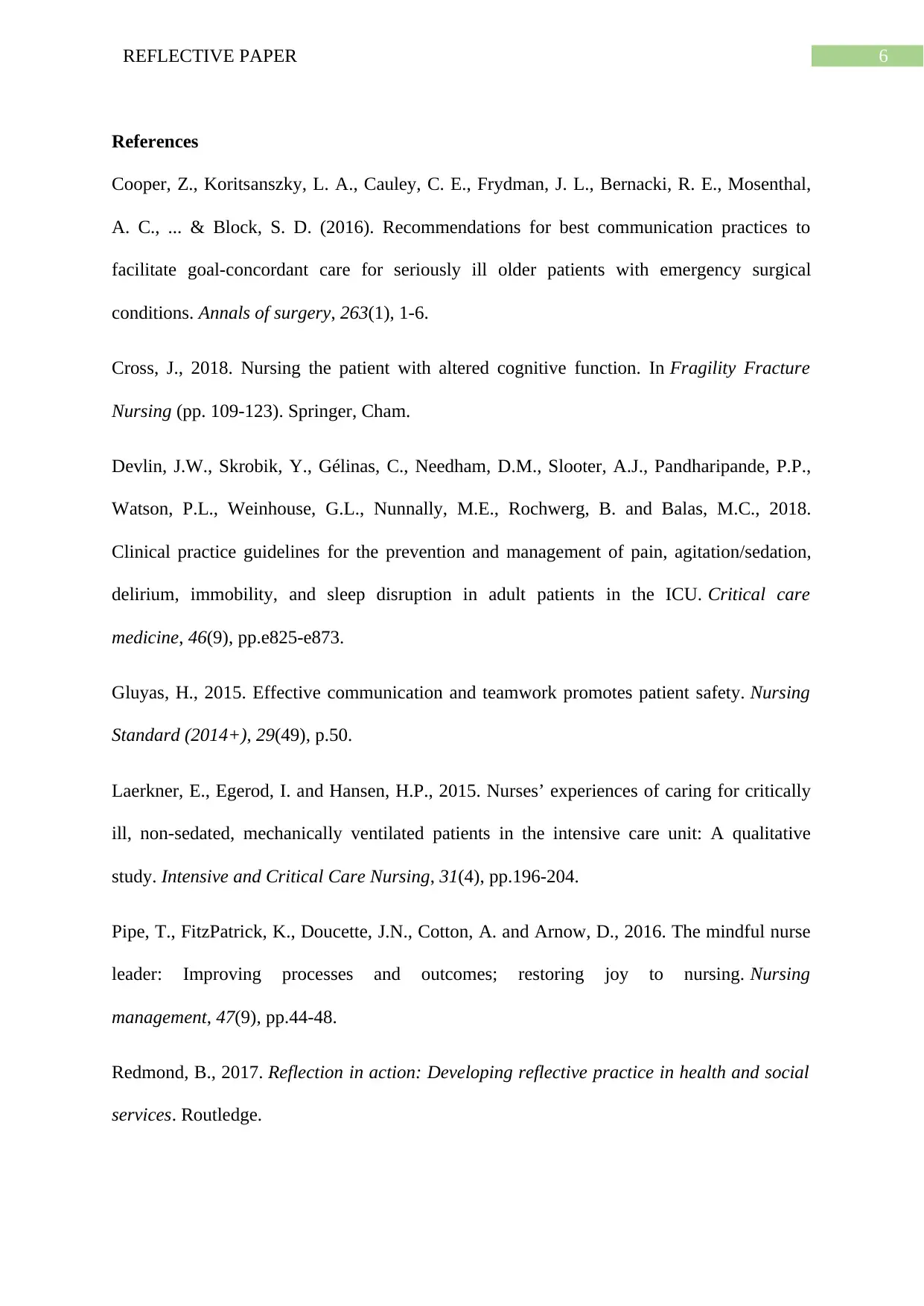
6REFLECTIVE PAPER
References
Cooper, Z., Koritsanszky, L. A., Cauley, C. E., Frydman, J. L., Bernacki, R. E., Mosenthal,
A. C., ... & Block, S. D. (2016). Recommendations for best communication practices to
facilitate goal-concordant care for seriously ill older patients with emergency surgical
conditions. Annals of surgery, 263(1), 1-6.
Cross, J., 2018. Nursing the patient with altered cognitive function. In Fragility Fracture
Nursing (pp. 109-123). Springer, Cham.
Devlin, J.W., Skrobik, Y., Gélinas, C., Needham, D.M., Slooter, A.J., Pandharipande, P.P.,
Watson, P.L., Weinhouse, G.L., Nunnally, M.E., Rochwerg, B. and Balas, M.C., 2018.
Clinical practice guidelines for the prevention and management of pain, agitation/sedation,
delirium, immobility, and sleep disruption in adult patients in the ICU. Critical care
medicine, 46(9), pp.e825-e873.
Gluyas, H., 2015. Effective communication and teamwork promotes patient safety. Nursing
Standard (2014+), 29(49), p.50.
Laerkner, E., Egerod, I. and Hansen, H.P., 2015. Nurses’ experiences of caring for critically
ill, non-sedated, mechanically ventilated patients in the intensive care unit: A qualitative
study. Intensive and Critical Care Nursing, 31(4), pp.196-204.
Pipe, T., FitzPatrick, K., Doucette, J.N., Cotton, A. and Arnow, D., 2016. The mindful nurse
leader: Improving processes and outcomes; restoring joy to nursing. Nursing
management, 47(9), pp.44-48.
Redmond, B., 2017. Reflection in action: Developing reflective practice in health and social
services. Routledge.
References
Cooper, Z., Koritsanszky, L. A., Cauley, C. E., Frydman, J. L., Bernacki, R. E., Mosenthal,
A. C., ... & Block, S. D. (2016). Recommendations for best communication practices to
facilitate goal-concordant care for seriously ill older patients with emergency surgical
conditions. Annals of surgery, 263(1), 1-6.
Cross, J., 2018. Nursing the patient with altered cognitive function. In Fragility Fracture
Nursing (pp. 109-123). Springer, Cham.
Devlin, J.W., Skrobik, Y., Gélinas, C., Needham, D.M., Slooter, A.J., Pandharipande, P.P.,
Watson, P.L., Weinhouse, G.L., Nunnally, M.E., Rochwerg, B. and Balas, M.C., 2018.
Clinical practice guidelines for the prevention and management of pain, agitation/sedation,
delirium, immobility, and sleep disruption in adult patients in the ICU. Critical care
medicine, 46(9), pp.e825-e873.
Gluyas, H., 2015. Effective communication and teamwork promotes patient safety. Nursing
Standard (2014+), 29(49), p.50.
Laerkner, E., Egerod, I. and Hansen, H.P., 2015. Nurses’ experiences of caring for critically
ill, non-sedated, mechanically ventilated patients in the intensive care unit: A qualitative
study. Intensive and Critical Care Nursing, 31(4), pp.196-204.
Pipe, T., FitzPatrick, K., Doucette, J.N., Cotton, A. and Arnow, D., 2016. The mindful nurse
leader: Improving processes and outcomes; restoring joy to nursing. Nursing
management, 47(9), pp.44-48.
Redmond, B., 2017. Reflection in action: Developing reflective practice in health and social
services. Routledge.
Paraphrase This Document
Need a fresh take? Get an instant paraphrase of this document with our AI Paraphraser

7REFLECTIVE PAPER
Smith, J. and Roberts, R., 2015. Reflective practice. Vital Signs for Nurses: An Introduction
to Clinical Observations, pp.222-230.
Thompson, S. and Thompson, N., 2018. The critically reflective practitioner. Macmillan
International Higher Education.
Smith, J. and Roberts, R., 2015. Reflective practice. Vital Signs for Nurses: An Introduction
to Clinical Observations, pp.222-230.
Thompson, S. and Thompson, N., 2018. The critically reflective practitioner. Macmillan
International Higher Education.
1 out of 8
Related Documents
Your All-in-One AI-Powered Toolkit for Academic Success.
+13062052269
info@desklib.com
Available 24*7 on WhatsApp / Email
![[object Object]](/_next/static/media/star-bottom.7253800d.svg)
Unlock your academic potential
© 2024 | Zucol Services PVT LTD | All rights reserved.





